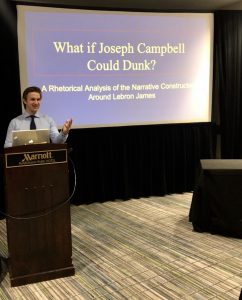Professor Kristen Chamberlain, who, along with Marceleen Mosher, presented a paper this past week at the Popular Culture Association conference in Washington, D.C. Their topic? “Failing Infrastructures: The Hydrosocial Cycle and Water in the U.S.” Senior communication studies and political science student, Kristian Evans, ’19, also presented at the conference. His topic? “What if Joseph Campbell Could Dunk? A Rhetorical Analysis of the Narrative Constructed Around LeBron James” Chamberlain advised Evans on the project.
“Failing Infrastructures: The Hydrosocial Cycle and Water in the U.S.”
The water crisis in Flint, Michigan illuminated a startling concern across the United States of aging infrastructures and limited public investment. Residents lacked both the financial freedom to invest in their own community and a representative voice in the decisions that impact them. But Flint’s underlying problem is not unique. Our water infrastructure is at risk and buried out of sight in many modern-day, fiscally strapped communities – both literally and figuratively. This hidden landscape lies at the intersection of both the natural and built water supplies we all rely on. Grounded in the hydrosocial cycle, we seek to situate the inherent flaws in solving community water infrastructure challenges with budget forward approaches. It is critical for policymakers and community members to examine water in relation to its role in modern day society and its very stake in humanity’s survival.
“What if Joseph Campbell Could Dunk? A Rhetorical Analysis of the Narrative Constructed Around LeBron James”

LeBron James sits at the top of the American athletic hierarchy. No other star combines the same amount of talent, celebrity, and notoriety as James has since bursting onto the scene as a high school phenom in 2002 (“ESPN World Fame 100”, 2017). His life, from the blacktops of poverty-stricken Akron to NBA champion, has followed a narrative that aligns closely with Joseph Campbell’s “Hero’s Journey.” LeBron James has come to represent a symbol of the struggles and redemption of the city of Cleveland, the next generation of basketball superstars following Michael Jordan, and the continuation of a rich and complicated narrative of African-American athletes and their relationship social justice. Through this rhetorical analysis of sports media coverage, Nike advertising campaigns and other mediums that combine to perpetuate the myth that is LeBron James, one can both observe how these forces combine to tell a heroic story and better understand the usefulness of Campbell’s Heroic Journey as it pertains to modern day athletes.
